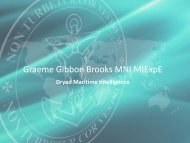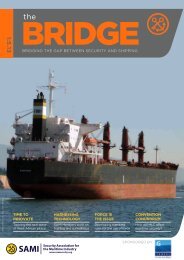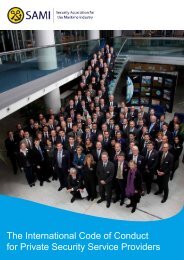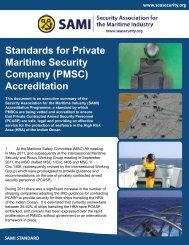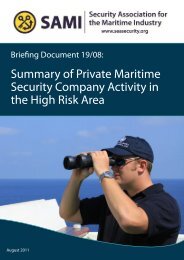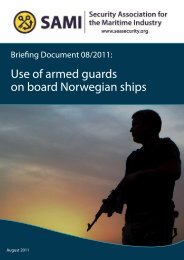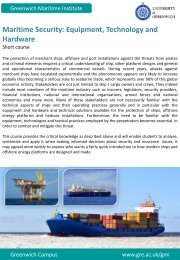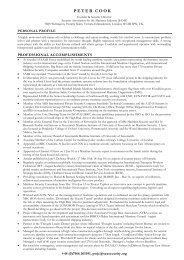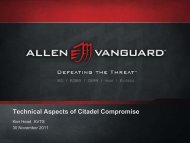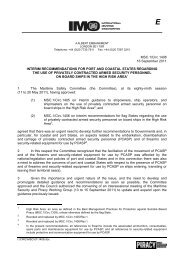B. Questions about the workers <strong>and</strong>the ships covered by the MLC, 2006B1. Who is protected by the MLC, 2006?The MLC, 2006 applies to “seafarers” as defined in its Article II, paragraph 1(f), thatis all persons who are employed or are engaged or work in any capacity on board a ship towhich the <strong>Convention</strong> applies [see B4. What ships does the MLC, 2006 apply to?]. Thisdefinition thus includes not just the crew involved in navigating or operating the ship butalso, for example, hotel personnel working on the ship. There could be cases where it is notclear whether a category of workers are to be regarded as “seafarers” covered by the<strong>Convention</strong>. Article II, paragraph 3, addresses this situation. In the event of doubt, thenational competent authority [see A25. Who is the competent authority?] must make adetermination on the question after consultation with the shipowners’ <strong>and</strong> seafarers’organizations concerned. In 2006 when it adopted the MLC, 2006 the International <strong>Labour</strong>Conference also adopted a Resolution concerning information on occupational groups,(see Resolution VII of the 94th ILC MLC, 2006 Resolutions) 15 which providesinternational tripartite guidance on factors to consider in making determinations in thesecases.B2. Does the MLC, 2006 apply to entertainers <strong>and</strong> hotel service staff?Since the MLC, 2006 applies to “any person who is employed or engaged or works inany capacity on board a ship to which this <strong>Convention</strong> applies” [see B1. Who is protectedby the MLC, 2006?], it covers all workers including cabin <strong>and</strong> cleaning personnel, barstaff, waiters, entertainers, singers, kitchen staff, casino personnel <strong>and</strong> estheticians. Thisconclusion is applicable irrespective of whether the seafarers concerned have beenrecruited directly by a shipowner or are employed under a subcontracting arrangement.Nevertheless, there are certain categories of workers, who only board the ship briefly <strong>and</strong>who normally work on l<strong>and</strong>, for example flag State or port State control inspectors, whoclearly could not be considered as working on the ship concerned. In other cases, thesituation may not be clear, for example when a performer has been engaged to work on acruise ship for the whole of the cruise or to carry out on going ship maintenance or repairor other duties on a voyage. In such cases, a determination will be necessary underArticle II paragraph 3, mentioned in answer to the question [see B1. Who is protected bythe MLC, 2006?].B3. Does the MLC, 2006 apply to cadets?On the assumption that cadets are performing work on the ship, although undertraining, they would be considered as “seafarers” in accordance with the provisions <strong>and</strong>principles indicated in answer to the question [see B1. Who is protected by theMLC, 2006?].B4. What ships does the MLC, 2006 apply to?The MLC, 2006 defines a ship in Article II, paragraph (1)(i) as “a ship other than onewhich navigates exclusively in inl<strong>and</strong> waters or waters within, or closely adjacent to,15 To be found in Section “ILC Sessions” at: www.ilo.org/ilcFAQ 13
sheltered waters or areas where port regulations apply” [see B6. What are “shelteredwaters” etc.?]. The MLC, 2006 applies to all ships as so defined, whether publicly orprivately owned, that are ordinarily engaged in commercial activities except (see Article II,paragraph 4):• ships engaged in fishing or in similar pursuits;• ships of traditional build such as dhows <strong>and</strong> junks;• warships or naval auxiliaries.The MLC, 2006 recognizes (Article II, paragraph 5) that there may be situationswhere there is doubt as to whether it applies to a ship or particular category of ships. In theevent of doubt, the national competent authority [see A25. Who is the competentauthority?] must make a determination on the question after consultation with theshipowners’ <strong>and</strong> seafarers’ organizations concerned.B5. When is a ship considered to be “ordinarily engaged in commercialactivities”?The MLC, 2006 does not have a definition of the phrase “ordinarily engaged incommercial activities”, used in Article II, paragraph 4 [see B4. What ships does theMLC, 2006 apply to?]. This would be a matter for good faith determination by the countryconcerned, <strong>and</strong> subject to the usual oversight role taken by the Committee of Experts underthe ILO supervisory system (ILO supervisory system). 16B6. What are “sheltered waters” etc.?The MLC, 2006 does not explicitly define the terms “closely adjacent to” or“sheltered waters” used in Article II, paragraph 1(i) [see B4. What ships does theMLC, 2006 apply to?]. It is impossible to determine this question on an international levelfor all member States, since this determination could to a certain extent depend upon thegeographical or geological situations in each State. In principle, it would be for thecompetent authority of a Member that has ratified the MLC, 2006 to determine, in goodfaith <strong>and</strong> on a tripartite basis, taking into account the objectives of the <strong>Convention</strong> <strong>and</strong> thephysical features of the country, which areas could be considered as covering “shelteredwaters” <strong>and</strong> what distance away from those waters could be considered as “closelyadjacent to sheltered waters”. Any questions of doubt are to be resolved on the basis ofconsultation with the national social partners in accordance with paragraph 5 of Article II.B7. Can a ratifying country make exemptions from certain provisions of theMLC, 2006?Exemptions are possible to a limited extent <strong>and</strong> only where they are expresslypermitted by the <strong>Convention</strong> (most of the permitted exemptions are found in Title 3, onaccommodation). In addition, for ships less than 200 gross tonnage (GT) that do not go oninternational voyages, a country may (under Article II, paragraph 6) determine that it is notreasonable or practicable at the present time to apply certain details of the Code [see A9.What is the Code of the MLC, 2006?] <strong>and</strong> cover the subject matter of those provisions by16 See footnote 9.14 FAQ
- Page 8: C5.1. Flag State responsibilities .
- Page 11 and 12: the Convention regarding the need f
- Page 13 and 14: oard ships but are not directly inv
- Page 15 and 16: supervisory system (a system establ
- Page 18 and 19: A16. How does the MLC, 2006 make it
- Page 20 and 21: A19. What will happen to the mariti
- Page 27 and 28: authority?] as qualified to issue s
- Page 29 and 30: C1.3.b. Does this training requirem
- Page 31 and 32: It may be useful to also consider t
- Page 33 and 34: equirements for upgrading or promot
- Page 35 and 36: C2.3.h. Do the hour of rest and hou
- Page 37 and 38: C3. Title 3 Accommodation, recreati
- Page 39 and 40: y berths and lockers, chests of dra
- Page 41 and 42: C4.1.b. Must every ship have a ship
- Page 43 and 44: • the cost of safeguarding the pr
- Page 45 and 46: (b) facilities for sports and outdo
- Page 47 and 48: • Sickness benefit• Unemploymen
- Page 49 and 50: agreed upon international standards
- Page 51 and 52: provisions of Regulation 5.1.3 and
- Page 53 and 54: C5.1.o. What is the period of valid
- Page 55 and 56: (b)(c)to carry out any examination,
- Page 57 and 58: prevents ships being delayed by unn
- Page 59 and 60: certificate and DMLC should be the
- Page 61 and 62: C5.2.q. Are complaints confidential
- Page 64 and 65: INTERNATIONAL LABOUR CONFERENCECont
- Page 66 and 67: Maritime Labour Convention, 2006MAR
- Page 68 and 69: Maritime Labour Convention, 2006(b)
- Page 70 and 71: Maritime Labour Convention, 20062.
- Page 72 and 73:
Maritime Labour Convention, 2006Pla
- Page 74:
Maritime Labour Convention, 20062.
- Page 78:
Explanatory note to the Regulations
- Page 82 and 83:
Minimum requirements for seafarers
- Page 84 and 85:
Minimum requirements for seafarers
- Page 86 and 87:
Minimum requirements for seafarers
- Page 88 and 89:
Minimum requirements for seafarers
- Page 90 and 91:
Conditions of employmentTITLE 2. CO
- Page 92 and 93:
Conditions of employmentGuideline B
- Page 94 and 95:
Conditions of employment3. National
- Page 96 and 97:
Conditions of employment(a) hours o
- Page 98 and 99:
Conditions of employment4. Paragrap
- Page 100 and 101:
Conditions of employmentRegulation
- Page 102 and 103:
Conditions of employment(b) accommo
- Page 104 and 105:
Conditions of employmentciently and
- Page 106 and 107:
Accommodation, recreational facilit
- Page 108 and 109:
Accommodation, recreational facilit
- Page 110 and 111:
Accommodation, recreational facilit
- Page 112 and 113:
Accommodation, recreational facilit
- Page 114 and 115:
Accommodation, recreational facilit
- Page 116 and 117:
Accommodation, recreational facilit
- Page 118 and 119:
Accommodation, recreational facilit
- Page 120 and 121:
Health protection, medical care, we
- Page 122 and 123:
Health protection, medical care, we
- Page 124 and 125:
Health protection, medical care, we
- Page 126 and 127:
Health protection, medical care, we
- Page 128 and 129:
Health protection, medical care, we
- Page 130 and 131:
Health protection, medical care, we
- Page 132 and 133:
Health protection, medical care, we
- Page 134 and 135:
Health protection, medical care, we
- Page 136 and 137:
Health protection, medical care, we
- Page 138 and 139:
TITLE 5. COMPLIANCE AND ENFORCEMENT
- Page 140 and 141:
Compliance and enforcement(a) has t
- Page 142 and 143:
Compliance and enforcement7. Detail
- Page 144 and 145:
Compliance and enforcement14. A cer
- Page 146 and 147:
Compliance and enforcement5. If a M
- Page 148 and 149:
Compliance and enforcement(a) the i
- Page 150 and 151:
Compliance and enforcementGuideline
- Page 152 and 153:
Compliance and enforcement(c)(d)the
- Page 154 and 155:
Compliance and enforcementStandard
- Page 156 and 157:
APPENDIX A5-IThe working and living
- Page 158 and 159:
Appendix A5-IIThis is to certify:1.
- Page 160 and 161:
Appendix A5-IIMaritime Labour Conve
- Page 162 and 163:
Appendix A5-IISignature: ..........
- Page 166 and 167:
Appendix A5-IIThis Certificate is v
- Page 168 and 169:
APPENDIX B5-I - EXAMPLE OF A NATION
- Page 170:
Appendix B5-IDeclaration of Maritim




